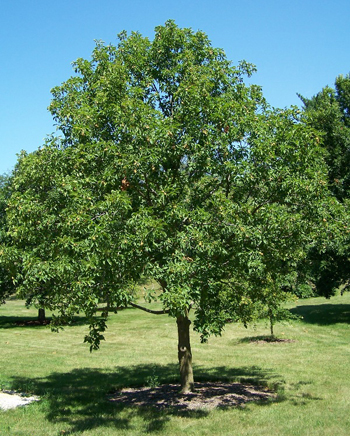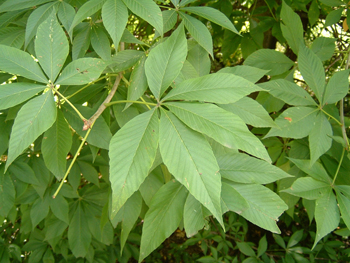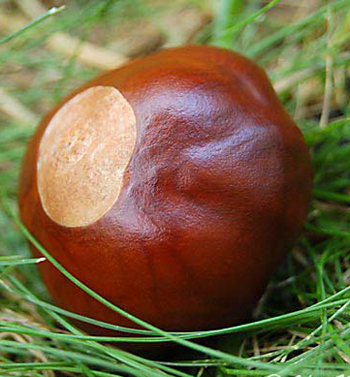Contents:
Common Names | Parts Usually Used | Plant(s) & Culture | Where Found
Legends, Myths and Stories | Uses | Warning | Bibliography
Scientific Names

- Aesculus glabra L.
- Horsechestnut family
Common Names
- Buckeye
Parts Usually Used
Nuts
Back to Top

Description of Plant(s) and Culture
Buckeye (named from the appearance of the seed). Any of various trees (genus Aesculus) of the horsechestnut family with large, spiny capsules enclosing shiny brown seeds.
Small tree; 20-24 foot. The palmate leaves, 4-15 inches long, with 5 toothed leaflets (rarely 4-7), and the yellowish blooms characterize this horsechestnut. Flowers in April to May. The nuts were once used medicinally, but are considered poisonous without elaborate processing. Twigs are foul-smelling when broken. Buds not sticky; scales at tips strongly ridged. Bark rough-scaly.
Back to Top
Where Found
A native of Ohio (called the Buckeye State). Found in rich, moist woods. West Pennsylvania, West Virginia, east Tennessee, central Alabama, central Oklahoma to Nebraska, Iowa.
Back to Top

Legends, Myths and Stories
The buckeye is best known among superstitious people as an amulet for good-luck. The seed is strung and worn as a necklace or simply carried about in pocket or purse.
American Indians put ground nuts in streams to stupefy fish, which floated to the surface for easy harvest. They roasted buckeyes, peeled and mashed them, then leached them, with the result that the toxic principle was removed, leaving a nourishing meal.
Old sources say the nuts will remove mildew stains from linen and a flour made from buckeyes makes an insect-proof paste of great tenacity much preferred by bookbinders. It is also said that moonshiners used the nuts to give their “liker” an aged appearance.
Still, even though considered toxic, American Indians made food from them after elaborate processing.
Back to Top
Uses
Ohio Buckeye traditionally used as powdered nut (minute doses) were used for spasmodic cough, asthma, intestinal irritations. Externally, tea or ointment used for rheumatism and piles.
Back to Top
Warning
Nuts of the buckeye are toxic, causing severe gastric irritation.
Should not be taken internally unless under medical supervision.
Back to Top
Bibliography
![]() Eastern/Central Medicinal Plants
Eastern/Central Medicinal Plants, by Steven Foster and James A. Duke., Houghton Mifflin Company, 215 Park Avenue South, New York, NY 10000
![]() American Folk Medicine
American Folk Medicine, by Clarence Meyer, Meyerbooks, publisher, PO Box 427, Glenwood, Illinois 60425, 1973
 Old Ways Rediscovered
Old Ways Rediscovered, by Clarence Meyer, Meyerbooks, publisher, PO Box 427, Glenwood, Illinois 60425, published from 1954, print 1988
![]() Webster’s New World Dictionary
Webster’s New World Dictionary, Third College Edition, Victoria Neufeldt, Editor in Chief, New World Dictionaries: A Division of Simon & Schuster, Inc., 15 Columbus Circle, New York, NY 10023
